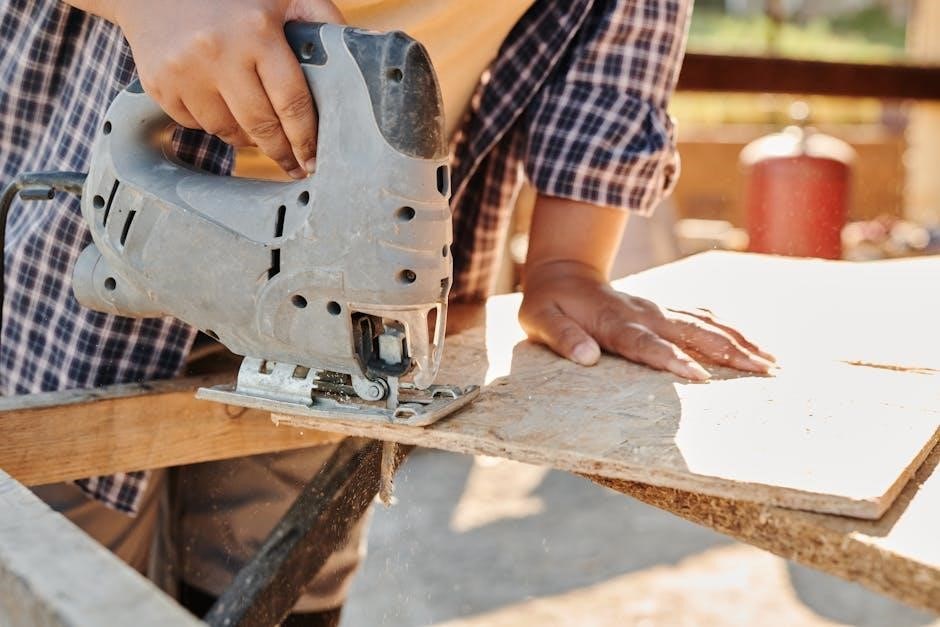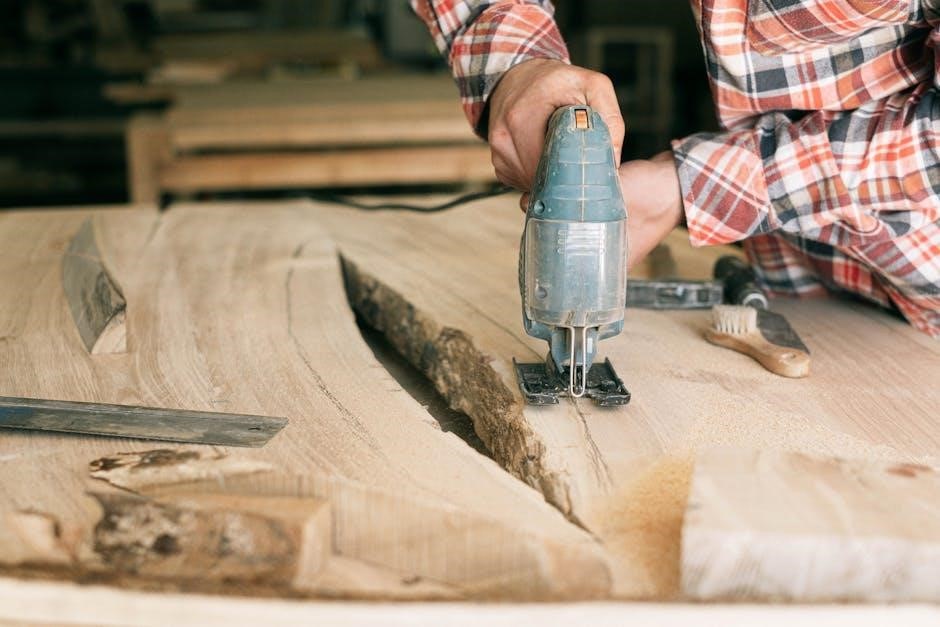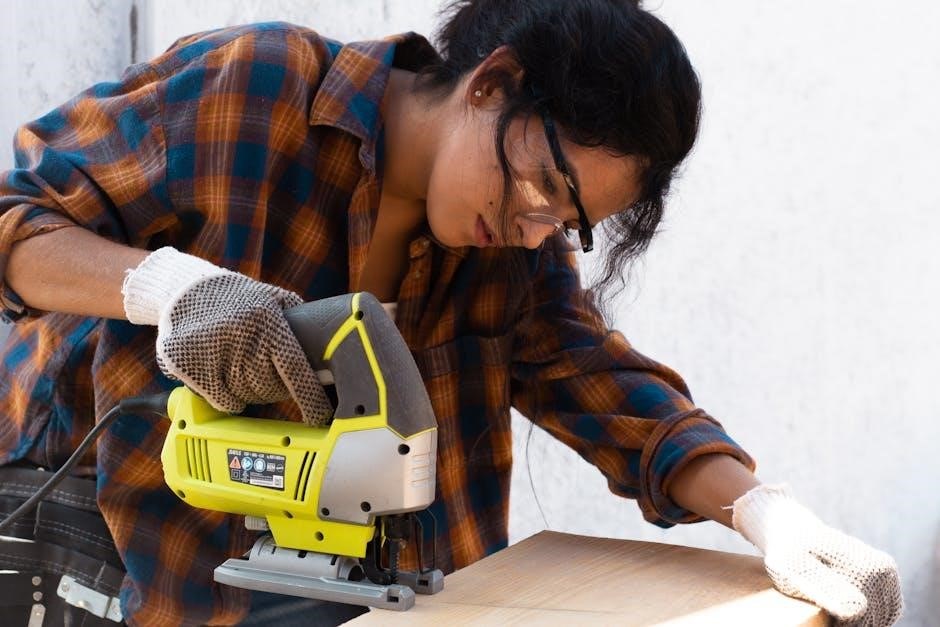Welcome to the Jigsaw Manual! This guide provides comprehensive instructions for safe and effective use of your jigsaw, covering essential techniques, maintenance, and safety tips.
1.1 What is a Jigsaw?
A jigsaw is a versatile power tool designed for making curved or irregular cuts in various materials like wood, metal, and plastic; It uses a reciprocating blade that moves up and down to cut through the material. Compact and portable, jigsaws are ideal for precision cutting and intricate designs. They are widely used in woodworking, DIY projects, and professional workshops. The tool’s ability to handle curved cuts makes it essential for crafts and furniture-making. By adjusting the blade type and speed, users can achieve clean cuts on different surfaces. This tool is a must-have for anyone requiring precise, detailed cutting capabilities.
1.2 Purpose of the Jigsaw Manual
The purpose of this manual is to guide users in safely and effectively operating their jigsaw. It covers essential safety precautions, tool components, and best practices for various cutting tasks. The manual aims to help both beginners and experienced users maximize their jigsaw’s potential while minimizing risks. By following the instructions, users can ensure optimal performance, maintain tool longevity, and achieve precise cuts across different materials. This comprehensive guide is designed to enhance your jigsaw experience, providing clear, actionable advice for every stage of operation and maintenance.

Safety Precautions
Always wear protective gear, secure the workpiece, and keep hands away from the blade. Ensure the area is well-lit and unplug the tool during blade changes or maintenance.
2.1 Essential Safety Tips
When operating a jigsaw, prioritize safety to minimize risks. Always wear safety glasses and consider hearing protection. Ensure the workpiece is securely clamped to prevent movement. Keep loose clothing and long hair tied back, and avoid jewelry that could catch. Maintain a firm grip on the tool and avoid overreaching. Never place your hands near the blade path. Use a sharp blade to reduce kickback risks. Unplug the jigsaw during blade changes or maintenance. Familiarize yourself with the manual and follow all safety guidelines to ensure a safe cutting experience.
2.2 Personal Protective Equipment (PPE)
Protecting yourself is crucial when using a jigsaw. Always wear safety glasses or goggles to shield your eyes from debris. A dust mask is essential for preventing inhalation of dust particles, especially when cutting through materials like wood or metal. Hearing protection, such as earplugs, is recommended due to the tool’s noise. Wearing safety gloves enhances grip and protects your hands from potential cuts. Additionally, wear closed-toe shoes and ensure no loose clothing or jewelry could interfere with the tool. Using proper PPE minimizes risks and ensures a safer working environment for all jigsaw operations.
2.3 Securing the Workpiece
Properly securing the workpiece is essential for safe and accurate cutting. Always use clamps or a vice to hold the material firmly in place, ensuring it doesn’t move during operation. A stable workpiece prevents vibrations and reduces the risk of accidents. Position the material on a sturdy, flat surface and tighten clamps evenly to avoid warping. Ensure the workpiece is aligned with your cutting line and remains stationary throughout the process. A secure setup allows for better control of the jigsaw and helps achieve precise cuts. Never attempt to cut loose or unsupported materials, as this can lead to dangerous situations.
2.4 Unplugging the Tool During Blade Changes
Always unplug the jigsaw before performing blade changes or maintenance. This critical safety step prevents accidental tool startup, reducing the risk of injury. Ensure the power cord is completely disconnected from the electrical outlet before touching any internal components. Never attempt to remove or install a blade while the tool is plugged in, even if it is turned off. Unplugging the jigsaw also protects the motor and electrical systems from potential damage. After completing the blade change, double-check that everything is securely in place before reconnecting the power source and resuming operation.

Understanding the Jigsaw
Familiarize yourself with the jigsaw’s components, such as the blade, shoe, and handle, to maximize its functionality and ensure precise cutting for various materials and projects.
3.1 Components of a Jigsaw
A jigsaw consists of key components that ensure efficient operation. The blade is the cutting element, available in various types for different materials. The shoe or base plate stabilizes the tool during cuts, while the handle provides grip and control. The motor powers the blade’s reciprocating motion. Additional features like speed control and orbital settings allow customization of cutting speed and aggressiveness. Understanding these parts helps in optimizing the tool’s performance and longevity, ensuring precise and safe cutting experiences for diverse projects and materials.
3.2 Choosing the Right Blade
Selecting the appropriate blade is crucial for optimal performance. Blades vary based on material type, such as wood, metal, or plastic. Tooth count is key: fewer teeth cut faster but less precisely, while more teeth offer smoother cuts. Blade thickness also matters, with thicker blades providing stability for straight cuts and thinner onessuited for curves. Additionally, consider special blade features like tanto teeth for durability or reverse teeth for reduced splintering. Matching the blade to your project ensures efficiency, accuracy, and extended tool life, making your cutting tasks safer and more effective.

Operating the Jigsaw
Operating the jigsaw safely and effectively requires knowledge of its controls, proper handling, and adherence to cutting techniques for accurate and clean cuts.
4.1 Starting the Jigsaw
Before starting, ensure the jigsaw is unplugged and the blade is securely installed. Wear safety goggles and gloves. Plug in the tool, hold it firmly, and squeeze the trigger gently for a smooth start. Position the blade just above the cutting line without touching the material. Apply steady, consistent pressure, maintaining control throughout the cut. Avoid sudden movements to ensure accuracy and safety.
- Always ensure the blade is sharp and properly secured.
- Keep loose clothing tied back and avoid distractions while operating.
4.2 Proper Cutting Technique
Hold the jigsaw firmly with both hands, maintaining control throughout the cut. Apply steady, consistent pressure to avoid applying too much force, which can cause blade breakage. Keep the blade straight and aligned with the cutting line, using the shoe as a guide. Use a smooth, even motion, especially when navigating curves or bevels. Avoid twisting the tool, as this can damage the blade or lead to uneven cuts. For straight cuts, use a guide or marker to keep the blade on track. Proper technique ensures accurate results and prolongs blade life.
4.3 Handling Curves and Bevels
Use a thin, flexible blade for curves and tight spaces. Move slowly and steadily to maintain accuracy. For complex curves, employ a spiral blade or use a template to guide the saw. Always secure the workpiece with clamps to prevent movement. When creating bevels, tilt the jigsaw while keeping the blade aligned with the desired angle. Apply consistent pressure to avoid unevenness. Adjust the orbital setting to minimize cuts; Practice on scrap material to refine your technique. Proper control and blade selection ensure smooth, professional-looking curves and bevels.

Maintenance and Care
Regularly clean the jigsaw with a dry cloth, focusing on the blade and motor. Lubricate moving parts to ensure smooth operation and prevent overheating.
5.1 Cleaning After Use
Cleaning your jigsaw after each use is essential for maintaining its performance and longevity. Use a dry cloth to wipe down the tool, paying special attention to the blade area and motor. Remove any dust or debris that may have accumulated during use. Avoid using liquids, as they can damage electrical components. Regular cleaning prevents rust and ensures smooth operation. Additionally, inspect the blade for residue and clean it gently with a soft brush. Proper maintenance helps extend the lifespan of your jigsaw and keeps it functioning efficiently for future projects.
5.2 Blade Maintenance and Replacement
Regular blade maintenance is crucial for optimal jigsaw performance. Inspect the blade frequently for wear, dullness, or damage. Replace blades with bent, broken, or worn teeth immediately, as they can cause uneven cuts or kickbacks. Always unplug the tool before replacing or adjusting blades. Use a soft cloth or brush to remove debris from the blade. Store blades in a dry, protected area to prevent rust. Proper blade care ensures precise cuts, reduces vibration, and extends the tool’s lifespan. Replace blades according to the manufacturer’s guidelines for different materials and tasks.

Troubleshooting Common Issues
Identify and resolve common issues such as jammed blades or uneven cuts. Regular blade checks and proper tool maintenance can prevent most problems. Use sharp, undamaged blades for optimal performance.
6.1 Dealing with Jammed Blades
A jammed blade can occur due to improper material feeding or blade damage. To resolve this, unplug the jigsaw immediately for safety. Inspect the blade for bent or broken sections and remove any debris. If the blade is damaged, replace it with a sharp, suitable one. Ensure the workpiece is securely clamped to prevent movement. Avoid forcing the jigsaw, as this can worsen the issue. Regular blade maintenance and proper cutting techniques can help prevent jams. Always refer to the manual for specific guidance on blade removal and replacement procedures.
6.2 Addressing Uneven Cuts
Uneven cuts can occur due to blade dullness, improper technique, or material movement. To address this, ensure the workpiece is securely clamped to prevent shifting. Use a sharp, high-quality blade suitable for the material. Maintain steady, consistent control of the jigsaw, avoiding excessive pressure. If the cut wanders, stop and realign the blade with the cutting line. Adjusting the orbital setting can also improve cut accuracy. Regular blade maintenance and proper tool calibration will help achieve smoother, more even results. Always follow the manufacturer’s guidelines for optimal performance and material-specific blade recommendations.

Additional Tips for Effective Cutting
Discover expert techniques and essential tips for maximizing your jigsaw’s performance, ensuring precise cuts and extending blade life for optimal results every time.
7.1 Maximizing Blade Life
To maximize blade life, always use the correct blade for the material, avoid excessive pressure, and keep the blade lubricated. Regular cleaning and proper storage also help extend lifespan.
7.2 Working with Different Materials
When working with various materials, adjust your technique and blade type accordingly. For wood, use a toothed blade and steady pressure. Metal requires a fine-tooth blade and slower speeds to prevent overheating. Plastic and PVC should be cut with a blade designed for smooth finishes to avoid melting. Always pilot drill for curved cuts and maintain consistent control to ensure accurate results. Proper material-specific adjustments enhance cutting efficiency and prevent damage to both the blade and the workpiece.
Congratulations! You’ve completed the Jigsaw Manual guide. By following these instructions, you’ll master safe and efficient jigsaw operation. Always prioritize safety, proper blade selection, and maintenance to extend tool life and ensure precise cuts. Remember to stay focused, use protective gear, and keep your workspace organized. With practice, you’ll achieve professional results in various projects. Happy cutting!



